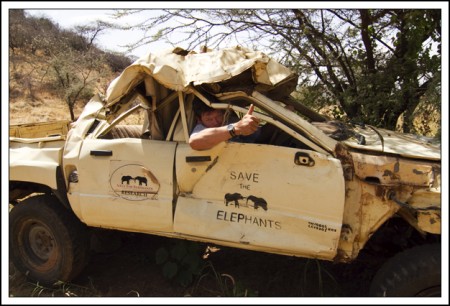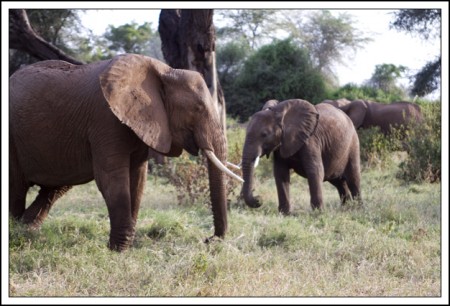I just had to run this photo of Iain Douglas-Hamilton standing next to this smashed Toyota pickup. There’s a story here, of course.
An elephant’s life expectancy is about the same as a human’s, and just like us, you can pretty much divide it into three parts. For the first twenty years or so, they are just growing up and trying to figure things out. For the next thirty years, a male elephant is in his breeding prime. And then for another twenty or twenty-five years they grow old and grumpy and die. As Robert Ruark wrote of this stage, “There would come a day when another bull would challenge him and defeat him and drive him off from the herd, and he would then roam about with his own acolytes, growing older and sourer and fuller of malice toward everything. His feet would hurt and his teeth would ache from decay in the mammoth nerve, and ants would crawl up his trunk and drive him mad. He would run amok and trample native shambas and crush in the water holes, and finally somebody from the Game Department would come along and shoot him and take his tusks back to the D.C. in Isiolo.”
So, two researchers from Save the Elephants were out in the field doing their thing when they came upon one of these old, bad-tempered rogue elephants (I think Iain told me it was Pretty Bom Bom, but I can’t remember for sure). Probably his feet hurt and his teeth ached and he was undoubtedly in a foul mood for, without provocation, he charged the researcher’s Toyota. You see that little crease on the door just to the left of the Save the Elephants logo? Well, that’s where the bull first hit. His tusk glanced off the door and went through the window and came out through the roof. Then he rolled the Toyota.
Amazingly, it landed back on its wheels. But the old fella wasn’t through. He came back for a second charge and this time his tusk went clear through the back seat and came out the middle of the roof. You can see the entry and exit points and all you can think is, My god, those poor people inside the Toyota must have been smashed and bloodied.
But, no, they were not. Miraculously, neither researcher was hurt. And the bull elephant, having spent his anger, marched off.
But here’s the really remarkable thing: After the elephant left, the two quivering researchers wondered how in the world they were going to get back to the research center. Because they were crazy with fear and not thinking clearly, they tried to start the pickup. And it cranked right up. And drove just fine all the way back.
It still works. Iain told me that when they want to freak out Samburu tourists going around in minivans, they’ll crawl into the wrecked pickup and drive it around. “We always get a chuckle out of that,” he says.
So just for fun, I had the photographer, Pete McBride crawl into the Toyota so I could take his picture. It wasn’t easy. He had to carefully slip through the shattered windshield, trying to avoid all the rusty sharp edges of the smashed frame and then fight through all the cobwebs and insect nests. But it made for a great photo.





Recent Comments